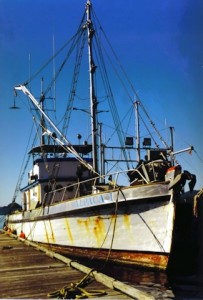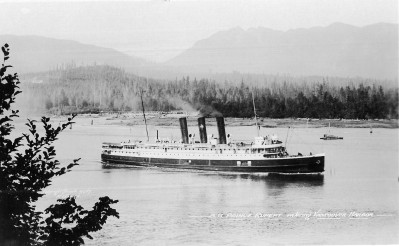This month marks eight years since I left the media and joined Tourism Prince Rupert, and 35 years since I published my first US magazine story.
I barely remember the beginning – especially since I started out writing under pseudonyms, and didn’t keep copies of anything until the late 1980s. I can remember only that the first sale was to a magazine based in Texas. From that first cheque I bought a shiny new 1976 quarter. I drilled a hole and wore it under my shirt until I finally saw the last of the rejection slips in the early 1980s.
Meantime I went into the media and worked literally from coast to coast – in broadcast and print, rising eventually through to promotions manager and station manager in radio, and to editor, publisher and even owner at newspapers and magazines.
In the ‘90s I was drafted by Hollinger to “save†Prince Rupert This Week. Over time Hollinger wanted me elsewhere, and I had to quit my job a couple of times to make them let me stay, but in the end I closed our weekly here in 1999. I was shifted over to Thomson Newspapers to create a new weekly newspaper for delivery to all rural homes in the three prairie provinces.
Instead I dropped out of the game to stay in Prince Rupert, but finally bowed to economic pressure in 2002 and left to run a communications company in Calgary. Swinging through Rupert in 2003, en route to join the Nanaimo Daily News, I was asked to take on Tourism Prince Rupert to make some changes under a short-term contract. It was a good fit on both sides, so I stayed.
Writing, photography and publishing are vital skills in tourism marketing. Media and political work, and understanding individual business needs in order to provide effective marketing, were the most basic tools in the publisher’s toolkit. Heck, even just having been a radio promotions manager, simultaneously planning and managing huge events in multiple communities, was a good apprenticeship for TPR.
After all those years as a corporate manager it was strange to come into a non-profit society, but not as strange as it might have been. I was a founding member of a provincial archaeological society the same year I first published, 1976, and was then a founding member of a large airplane museum by the time I left high school. (Yeah, I was a weird kid.) Since then I’ve volunteered for god knows how many non-profit boards, so at least I started with an idea of what was needed.
My belief in Prince Rupert’s potential is stronger than ever. Writing in This Week beginning in 1996 I argued for stronger investment in tourism – having seen the rough, unplanned transition from resource to tourism economies at my most recent gig with CFCY Charlottetown. That might have been avoided in Prince Rupert, our transition could have been smoother, but I still believe, more than ever, in that promising future.
Each of the past eight years has brought both success and challenge. This year we had a great year in Prince Rupert, with a strong increase in the number of visitors. About half of the increased hotel revenue was likely due to growing success in attracting conferences, and the other half to a greatly increased number of independent visitors traveling the northern corridor. Still, certain sectors were weak – such as European visitation, due to the strong Canadian dollar – and the halibut closure slaughtered the tail end of an otherwise strong sport fishing season. Our tour operators are facing a 2012 season without a weekly cruise ship. Yet despite these factors tourism remains one of the most vital sectors of the Prince Rupert economy, and the successes of the past eight years have greatly outweighed the missed opportunities.
(First published in The Northern View, September 28, 2011.)







Rejection Slips
Most writers I meet these days haven’t even seen a real rejection slip. That always strikes me as odd, because rejection slips are how I learned to write.
I was surprised to find this little collection of 1970s rejection slips. I didn’t know I still had these last few. They must have been misfiled someplace, and showed up only after the conservators were finished salvaging my files from a study flood. This odd little group might have been a handful of rejections for a single story all misfiled at the same time. Fantasy / science fiction wasn’t a common angle.
There was quite a process to endure before you earned a rejection slip. Writing the query letter seemed to take almost as long as the story. It was honed to perfection, with a carbon copy of it clipped to an active query board.
The story itself was perfectly formatted, likely typed at least a couple of times to produce a clean copy without a typo or a smudge.
There was an SASE enclosed—a self-addressed, stamped envelope—in case the piece wasn’t suitable for the magazine.
At the other end an editor scooped it out of the slush pile, glanced at the query and perhaps flipped to the lede of the story, grabbed a form rejection, stuffed the whole pile into your SASE, and within a minute returned it to you with the postage you paid for. If you were lucky, and something had caught the editor’s eye, he jotted a little note on the rejection slip. Each one of those little notes was worth more than an entire creative writing course.
Twenty years later, in the 1990s, I had stopped creative writing after a bad experience with a publishing house. To force myself back to work I plastered the walls of a room with old rejection slips. I had a lot of them. When I started I had out maybe 25 queries at any given time, and, especially in the beginning, most of those proposals ended in rejection.
In the middle of that room I placed a desk salvaged from a hotel room used by the entertainment at a local hotel and pub. I sat at the desk, listening to the stories of its cigarette burns and drink stains and carved graffiti from musicians and exotic dancers. Every slip of paper on the wall was a reminder of a lesson learned. Their purpose served, when I left that apartment I stripped down all of the rejection slips and threw them away.
Through persistence one eventually graduated. The first sign came in receiving personalized rejection letters instead of generic slips. That happened when an editor liked the voice, just not the story. The only remaining step was publication and pay.
That was the rejection slip challenge. The secret was, to quote a very detailed one from Isaac Asimov, that one’s story had “failed to rise far enough above the other 849 seen that month.†That provided the incentive. The challenge was simply to leave those 849 wannabes behind. To learn how to write your way to the top, you simply had to learn how not to write.